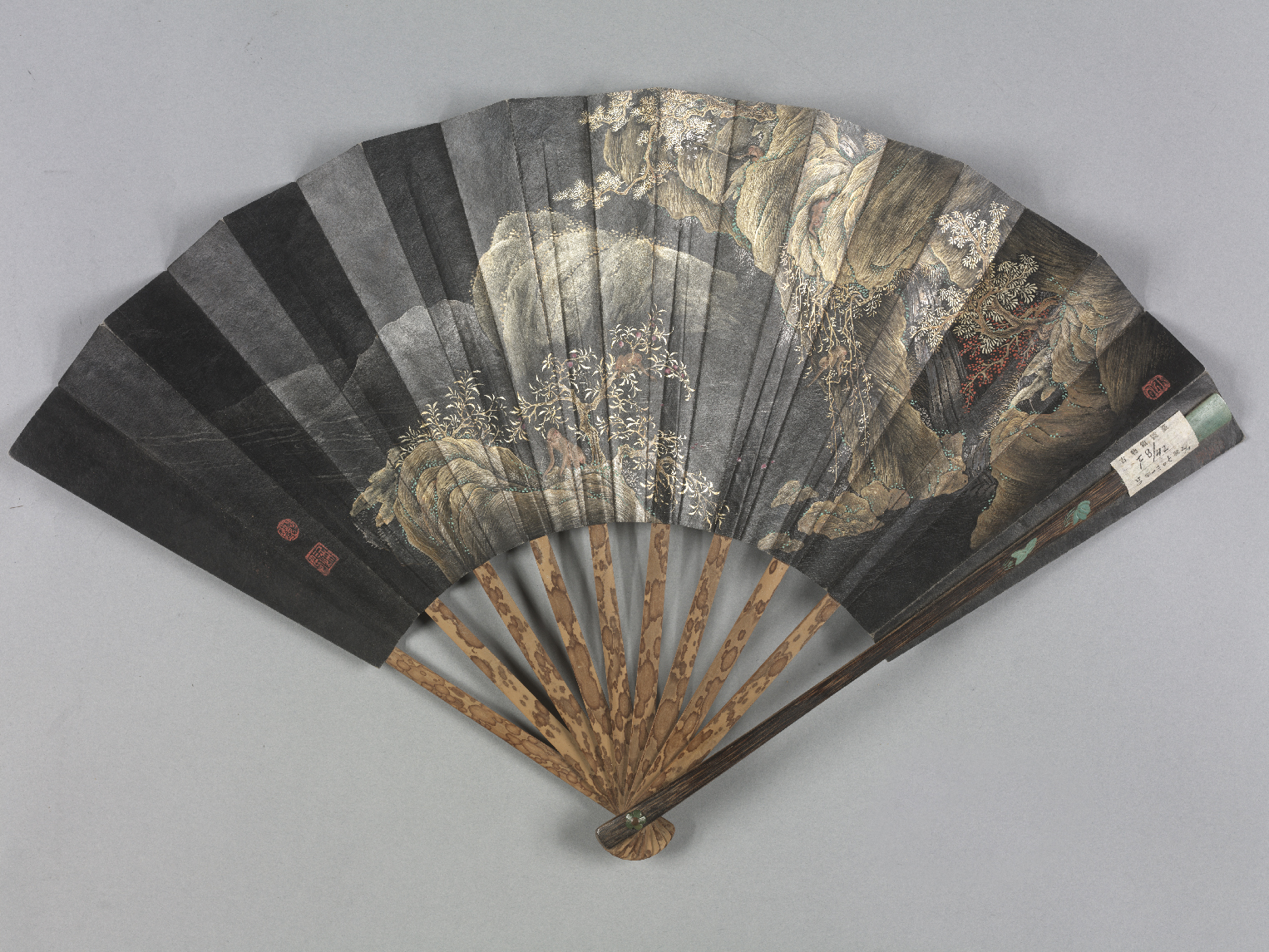Snug and Chill
In winter, would you put on a down jacket, wear a scarf, tack a hand warmer pad close to your body, or even turn on a heater to keep warm? In summer, would you hold a small fan in hand, retreat into an air-conditioned room and sip a cold drink? During the Ming and Qing periods when electricity was not yet available, how did the emperors, empresses and imperial concubines make themselves comfortable in the cold winter and hot summer?
Palace Museum 100: Summer and winter in the Forbidden City
Retrieved from: CCTV Documentary Channel on YouTube
Keeping snug
During cold winter days, not only was the Forbidden City replete with top-quality charcoal, light-weight exquisite hand warmers, fur coats and hats, there were also sporting activities to keep the palace residents warm.

Appreciating curios around a brazier, album of paintings depicting monthly activities inside the palace by Chen Mei, Qing Dynasty
Appreciating curios around a brazier, album of paintings depicting monthly activities inside the palace by Chen Mei, Qing Dynasty
Provided by the Palace Museum


Screen of Twelve Beauties Inscribed by Prince Yong, Qing Dynasty
Screen of Twelve Beauties Inscribed by Prince Yong, Qing Dynasty
Provided by the Palace Museum
Reading next to a brazier, appreciating antiques and taking in the snow scene were the pleasurable things to do on a wintry day.


Painted enamel flower-patterned tripod burner, Qing Dynasty
Painted enamel flower-patterned tripod burner, Qing Dynasty
Diameter: 42 cm Height: 72 cm.
Provided by the Palace Museum
Some burners had custom-made covers to prevent sparks from flying out. The covers also had to be aesthetically pleasing.

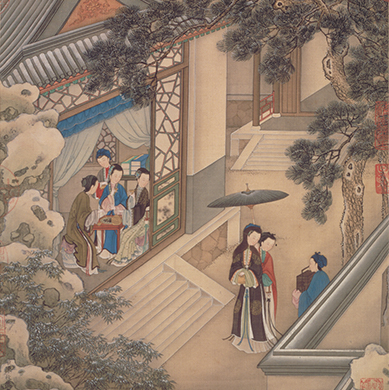
Finding inspiration for writing poem in the snow, from an album of paintings depicting monthly activities inside the palace by Chen Mei, Qing Dynasty
Finding inspiration for writing poem in the snow, from an album of paintings depicting monthly activities inside the palace by Chen Mei, Qing Dynasty
Provided by the Palace Museum
The figures in the painting are carrying hand warmers. They came in different forms and sizes which made them easy to carry around, whether in the sleeves or held by hand to keep snug.


Begonia-shaped hand warmer with gilt flowers and birds on a black lacquered ground, Yongzheng period, Qing Dynasty
Begonia-shaped hand warmer with gilt flowers and birds on a black lacquered ground, Yongzheng period, Qing Dynasty
Provided by the Palace Museum
Hand warmers in the Forbidden City were made from a diverse range of material, from painted enamel to metals such as gold, silver and copper.


Begonia-shaped hand warmer with painted enamel panels, Qing Dynasty
Begonia-shaped hand warmer with painted enamel panels, Qing Dynasty
Provided by the Palace Museum


Oval hand warmer with painted enamel panels, Mid-Qing period
Oval hand warmer with painted enamel panels, Mid-Qing period
Provided by the Palace Museum
Some hand warmers were so exquisitely made that they became not only functional items, but also decorative display ones.


Round hand warmer painted with ‘eight trigram’ pattern in enamel, Qing Dynasty
Round hand warmer painted with ‘eight trigram’ pattern in enamel, Qing Dynasty
Provided by the Palace Museum


Scroll painting depicting games on ice by Jin Kun (1662 - 1722) et al, Qing Dynasty
Scroll painting depicting games on ice by Jin Kun (1662 - 1722) et al, Qing Dynasty
Provided by the Palace Museum
There was a custom of holding games on ice in the Forbidden City during the Qing Dynasty. Emperor Qianlong once remarked that “the institution of the state encouraged games on ice” and treated it as a “state custom”. In this painting, it shows an event on the ice in the mid-winter season. The Emperor, noblemen and courtiers are watching skilled skaters score a goal by the Golden Turtle Jade Rainbow Bridge on the Taiye Pond. The thrill and pleasure brought by the sport chases away the cold.

Staying chill in the summer heat
One way to stay chill in the summer heat was to retreat to a summer resort. Other ways included ice cellars and refrigerator, beautiful fans of various makes and equipment such as manual fans.
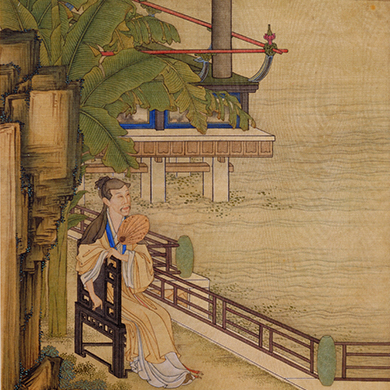
Album on Emperor Yongzheng at leisure, Qing Dynasty
Album on Emperor Yongzheng at leisure, Qing Dynasty
Provided by the Palace Museum

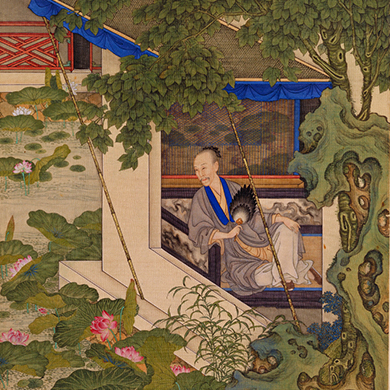
Album on Emperor Yongzheng at leisure, Qing Dynasty
Album on Emperor Yongzheng at leisure, Qing Dynasty
Provided by the Palace Museum


Large cloisonné enamel refrigerator with floral pattern, Qing Dynasty
Large cloisonné enamel refrigerator with floral pattern, Qing Dynasty
Provided by the Shenyang Palace Museum
The refrigerator is lined with tin which serves as an insulator to keep the temperature in the box low. There is also a small hole at the bottom which can be opened to discharge ice water and keep the inside of the box clean.


Icehouse
Icehouse
Photo by Liu Yedao


Gilt bronze cloisonné enamel fan with five bats, Qing Dynasty
Gilt bronze cloisonné enamel fan with five bats, Qing Dynasty
Provided by the Palace Museum
The top of the fan is in the image of the weapon ji and the musical instrument qing. They symbolize auspiciousness and abundance. The blades are in the shape of bats (or “fu”), a homonym for “blessings”. The cloisonné enamel gourd is a symbol of happiness and prosperity. The stand is decorated with bats and peaches, symbols of blessings and longevity. This fan carrying a lot of well-wishes is made in Canton (Guangzhou today). When it is wound up, the blades will turn and give a fresh breeze.


Round fan made of red kesi silk decorated with images of longevity, with carved black wood handle, Qing Dynasty
Round fan made of red kesi silk decorated with images of longevity, with carved black wood handle, Qing Dynasty
Provided by the Palace Museum
Kesi comprises raw silk as the warp threads and cooked silk as the weft threads. Draft patterns are first outlined on the warp threads. Then different colour sections are woven by using several or even dozens of separate bobbins, creating the same patterns on both the front and the back. The demanding technique makes it rare and precious. The pattern of houses on the sea is a traditional symbol of longevity in China.
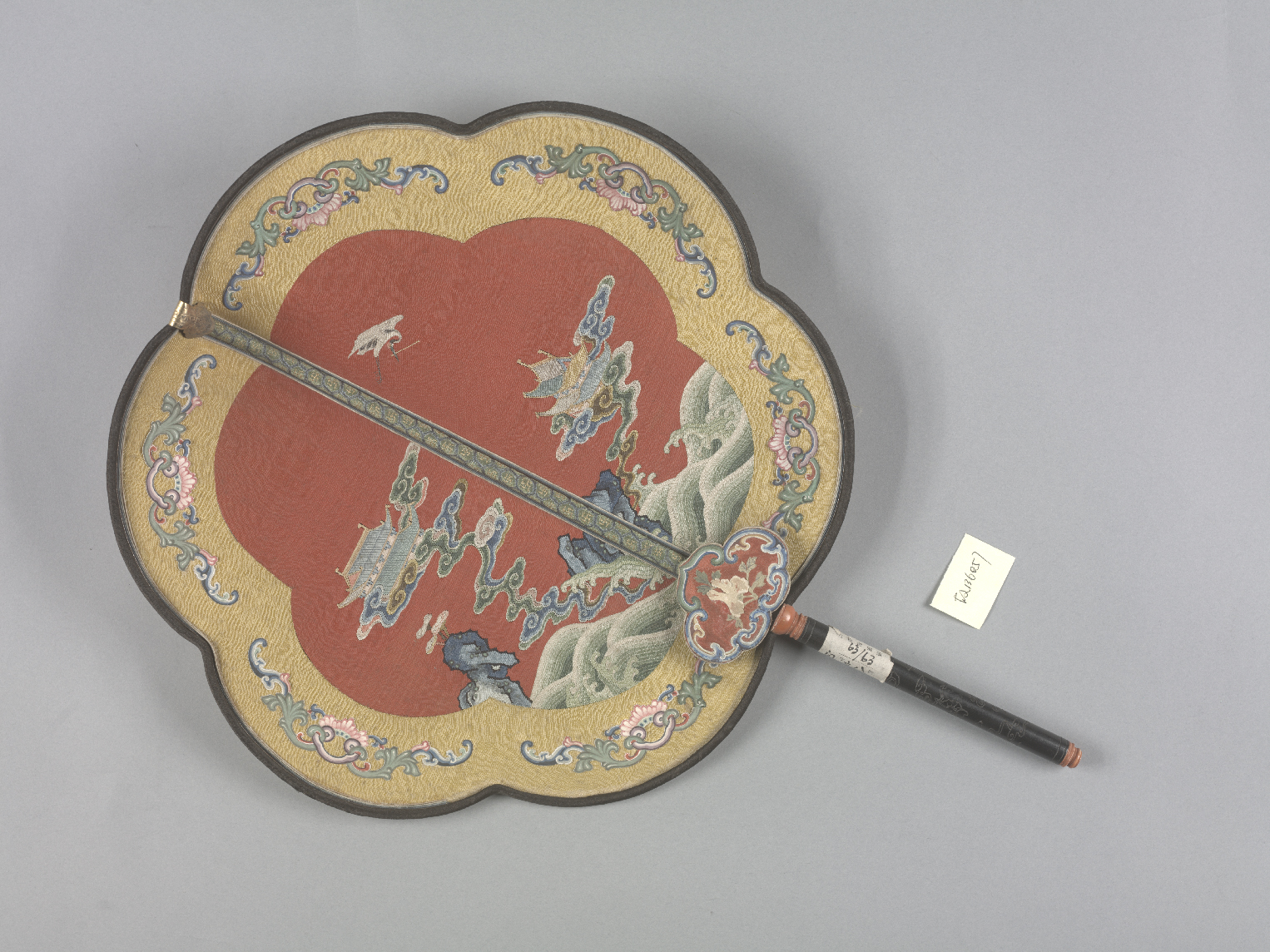

Satin round fan decorated with images of curios and floral pattern outlined with golden thread, bordered by silk and matched with bone handle, Qing Dynasty
Satin round fan decorated with images of curios and floral pattern outlined with golden thread, bordered by silk and matched with bone handle, Qing Dynasty
Provided by the Palace Museum
The Qing Imperial Palace made round fans in different forms and from a wide variety of fine materials. In addition to serving the function of fanning off the summer heat, these exquisitely crafted fans are now appreciated as works of art.
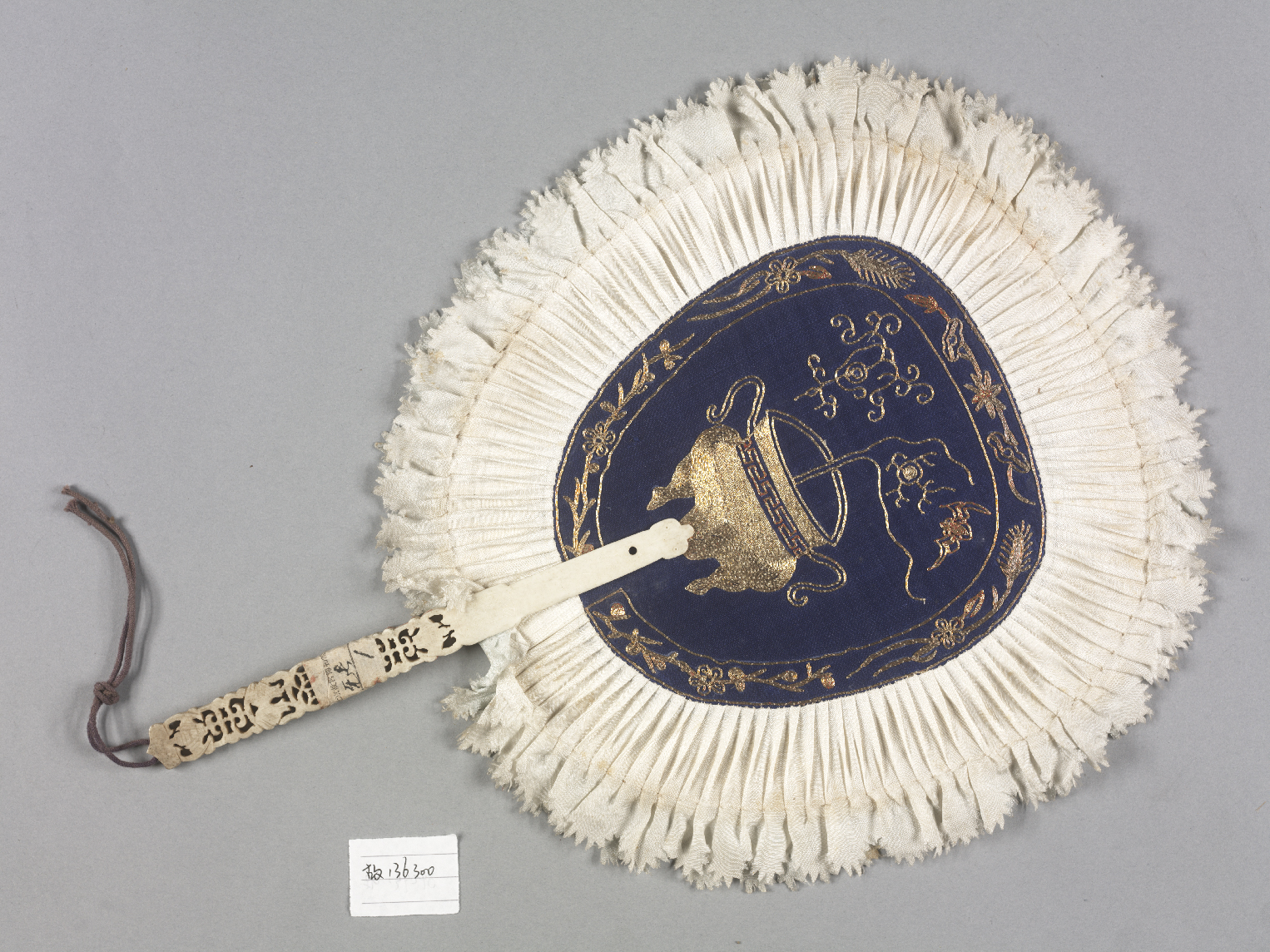

Round fan embroidered with peacock on white silk ground, matched with lacquered handle, Qing Dynasty
Round fan embroidered with peacock on white silk ground, matched with lacquered handle, Qing Dynasty
Provided by the Palace Museum
The technique of double-sided embroidery is adopted. Bold colours are used and the scene is vivid and lifelike.


Sitting alone in the pine shade, by Qiu Ying (ca. 1494 – 1552), Ming Dynasty
Sitting alone in the pine shade, by Qiu Ying (ca. 1494 – 1552), Ming Dynasty
From the collection of the National Palace Museum, Taipei
Qiu Ying was a native of Taicang in Jiangsu. He is one of the most famous painters in the Ming Dynasty, particularly well-known for his blue-green landscape paintings.


Landscape on folding fan by Emperor Daoguang (r. 1813 - 1820), Qing Dynasty
Landscape on folding fan by Emperor Daoguang (r. 1813 - 1820), Qing Dynasty
Provided by the Palace Museum
The making of black folding fans is very complicated: sturdy, high quality mulberry paper is used and several layers of persimmon paint are applied on both sides, followed by over 80 processes including pasting on the fan ribs, pleating, colouring and polishing. It does not get drenched in the rain and does not peel from exposure to the sun, and is very durable.
This painting of monkeys picking peaches or climbing by Emperor Daoguang is vividly done and is highly appealing.
